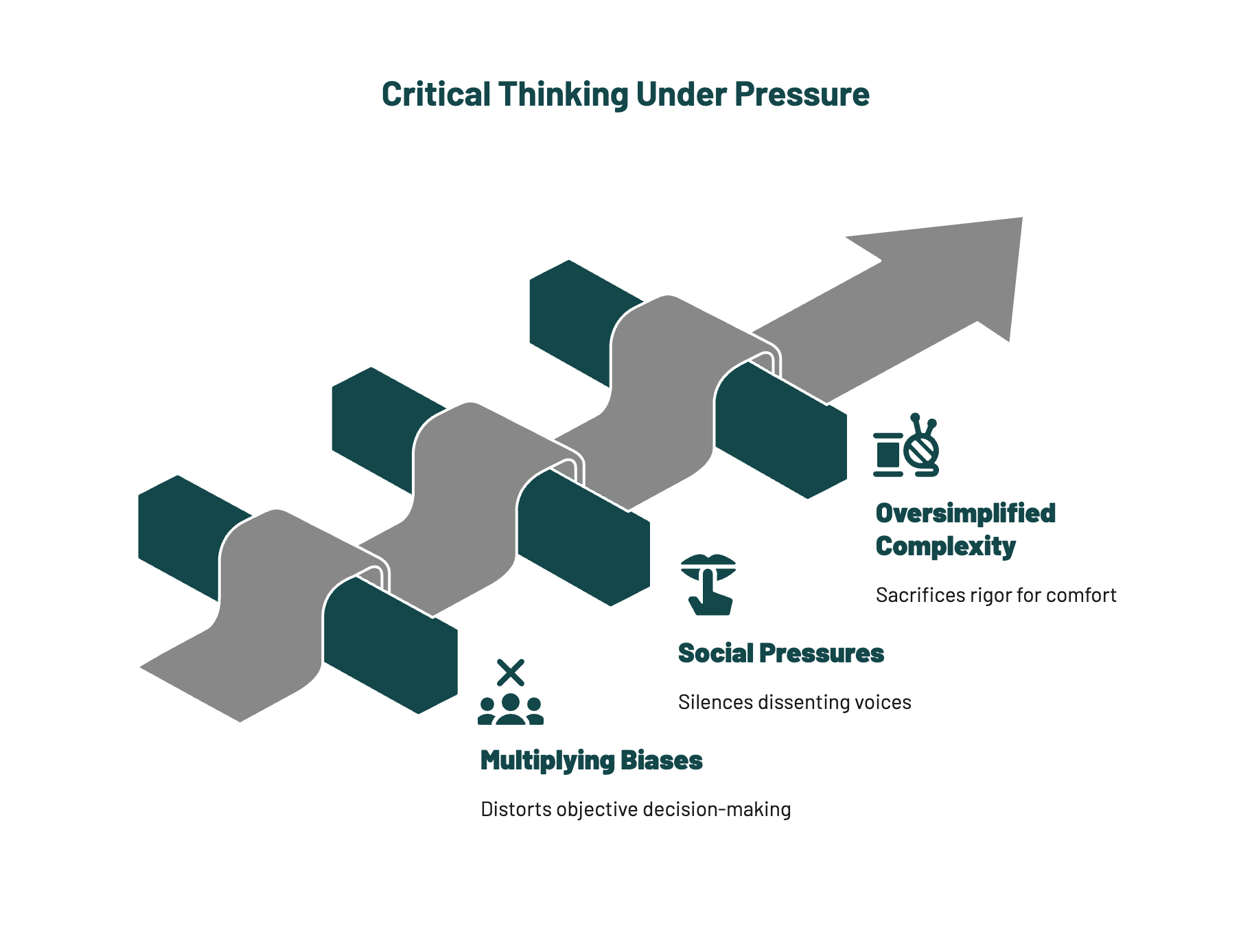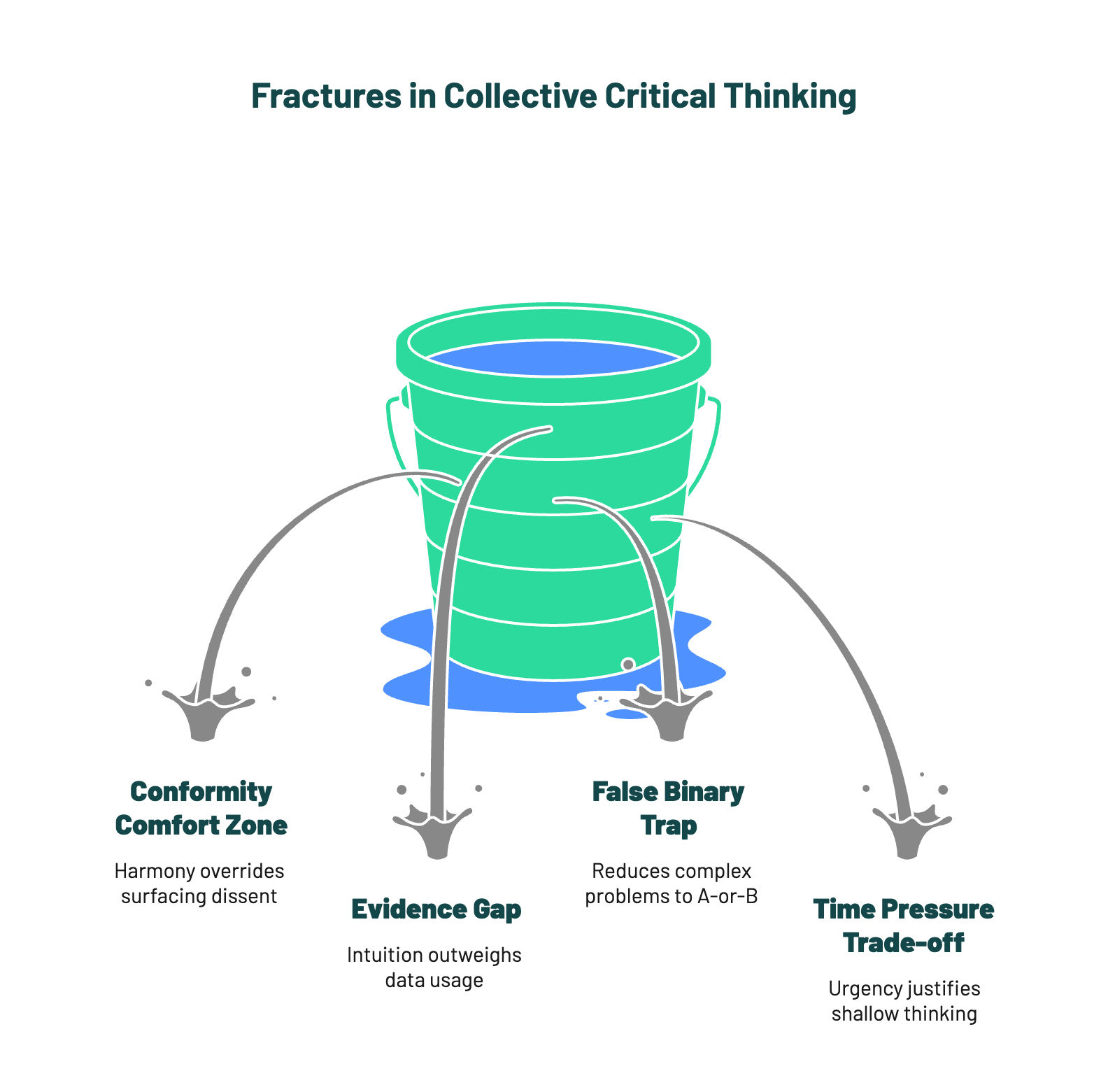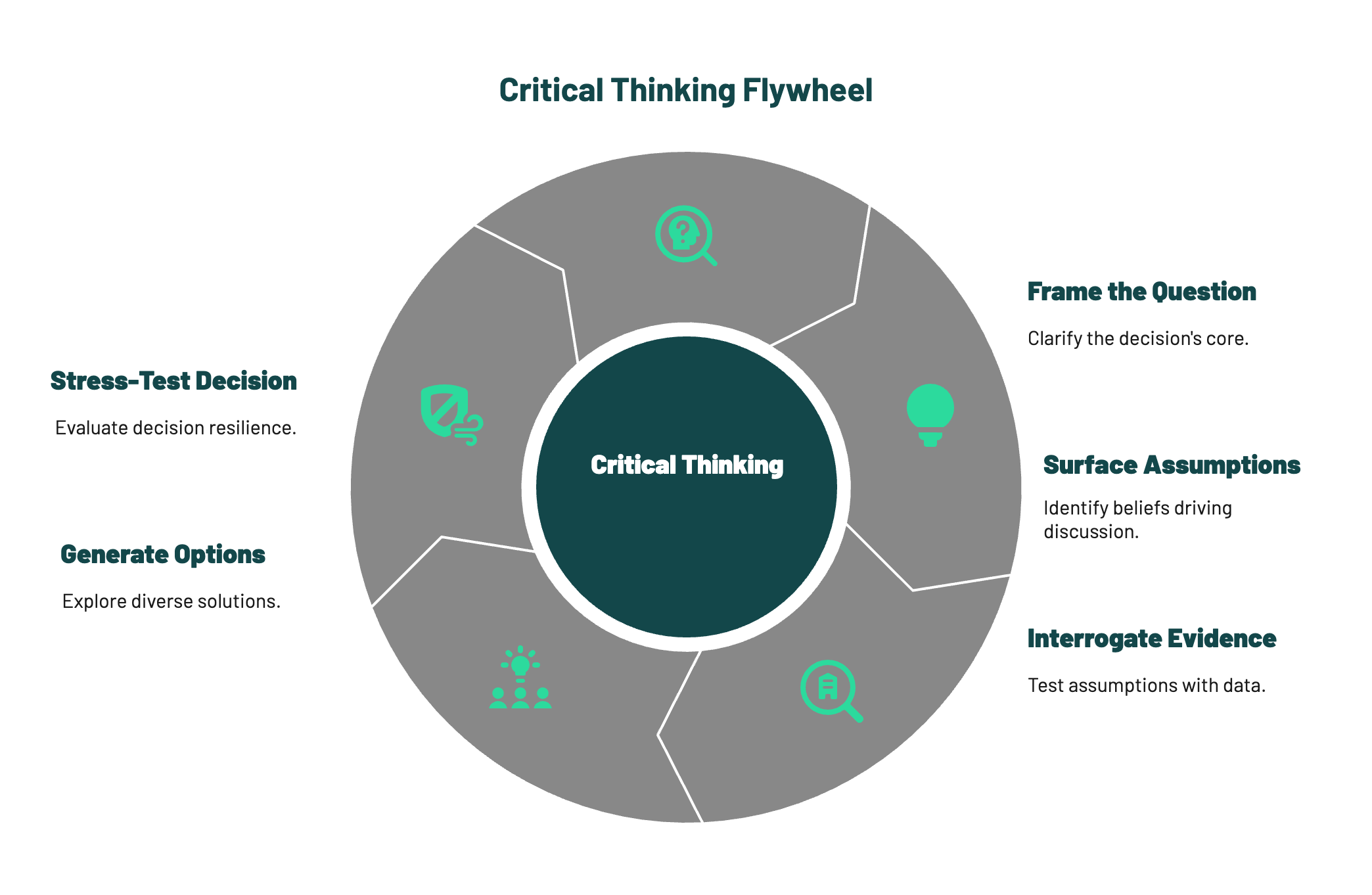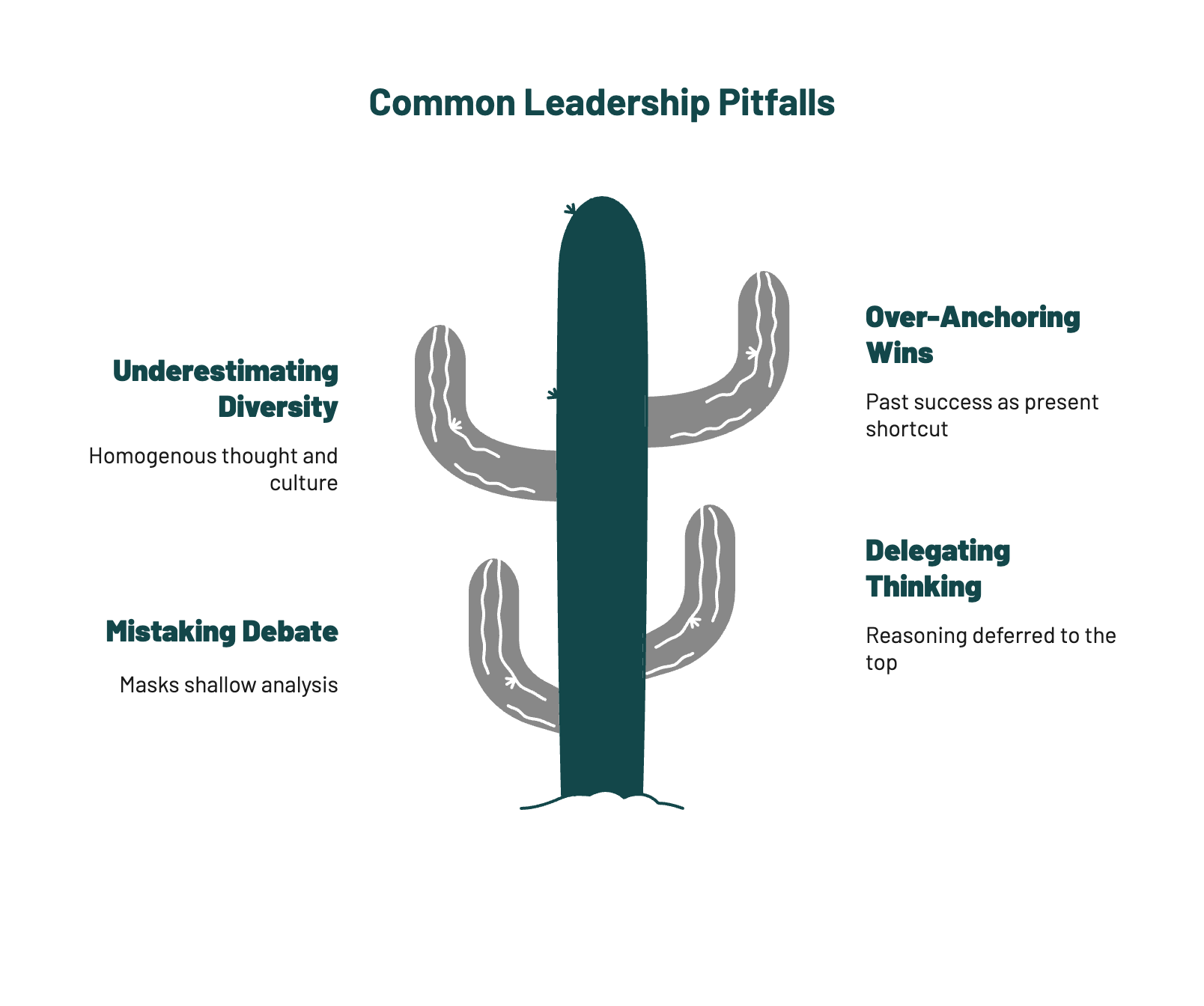Decision Making
August 13, 2025
5
Min
Why Most Teams Fail at Critical Thinking (and How to Fix It)
Critical Thinking
|
That gap between individual intelligence and team reasoning is where most organisations lose strategic ground. Critical thinking isn’t just a personal skill - it’s a collective discipline. And that discipline is rare.
For senior leaders, the ability to challenge assumptions, examine evidence, and weigh consequences is no longer a nice-to-have. It’s essential for navigating markets that change faster than annual planning cycles.
Research from McKinsey suggests that teams with strong critical thinking habits make decisions 2.5 times faster and with 50% fewer execution delays. This matters because execution lag - not lack of ideas - is the silent killer of strategy.
Yet we’ve seen high-performing individuals stumble when they sit around the same table. Biases multiply, social pressures silence dissent, and complexity gets over-simplified. The result? Comfort over rigour.

Over years of coaching leadership teams, we’ve identified four common fractures that quietly erode collective critical thinking.
The desire to maintain harmony overrides the need to surface dissent. People self-censor because they don’t want to be “that person” in the room.
Example: A tech firm’s leadership team agreed to launch a product feature despite a junior analyst’s data showing weak demand. Six months later, the feature was quietly retired.
Reflection prompt: When was the last time your team celebrated someone for changing the group’s mind?
Micro-action: At your next meeting, nominate a “devil’s advocate” to question the majority view without consequence.
Decisions lean on intuition and anecdote, while data and structured reasoning play a supporting role.
Example: A retailer expanded into a new market because “our competitor did it” without evaluating cost structures or consumer behaviour. The move drained working capital for two years.
Reflection prompt: Are your debates anchored in verifiable facts or in the loudest conviction?
Micro-action: Require a minimum of two independent data points before green-lighting major initiatives.
Complex problems are reduced to A-or-B choices, when the best solution may be somewhere else entirely.
Example: An NGO faced funding cuts and debated only between downsizing staff or cutting programs, missing a hybrid model involving strategic partnerships.
Reflection prompt: How often do you push the team to generate a third or fourth viable option?
Micro-action: Institute a “third option” rule - no decision is made until three plausible paths are on the table.
Urgency is used to justify shallow thinking. Decisions are rushed to “keep things moving” without clarifying what’s at stake.
Example: A manufacturing firm locked into a costly supplier contract to meet a deadline, ignoring a procurement analysis that was two weeks from completion.
Reflection prompt: How often does speed come at the expense of quality in your decision-making?
Micro-action: Build a shared playbook for when speed is critical versus when deeper analysis is non-negotiable.

To move from ad-hoc to disciplined collective reasoning, we use what we call the Critical Thinking Flywheel. It’s a repeatable 5-step model for team-based decisions.
The magic is not in the steps themselves but in building the habit until it’s cultural muscle memory.

Pro Tip: Introduce one ritual at a time. Cultural adoption beats checklist compliance.
The remedy is not more process but better-designed conversations.

When was the last time your team changed its mind based on new evidence rather than sticking to an initial plan?
Which meeting behaviours today would make an outsider question your team’s intellectual honesty?
Teams that practise collective critical thinking consistently deliver cleaner strategies, fewer false starts, and a culture where dissent is safe. Decisions are not just faster - they are stickier in execution because they’ve been pressure-tested from multiple angles.
The reward is organisational agility without the whiplash.
In your next decision meeting, make thinking visible. Document assumptions, evidence, and alternative options in real time. See how it changes the tone and the outcome.
Team SHIFT
Ever been in a meeting where the discussion feels busy but not productive? The group debates minor details, circles back on the same points, and still ends up making a decision that is more about consensus than clarity. On paper, the team is full of smart, capable people. In practice, the collective thinking is... average at best.
That gap between individual intelligence and team reasoning is where most organisations lose strategic ground. Critical thinking isn’t just a personal skill - it’s a collective discipline. And that discipline is rare.
For senior leaders, the ability to challenge assumptions, examine evidence, and weigh consequences is no longer a nice-to-have. It’s essential for navigating markets that change faster than annual planning cycles.
Research from McKinsey suggests that teams with strong critical thinking habits make decisions 2.5 times faster and with 50% fewer execution delays. This matters because execution lag - not lack of ideas - is the silent killer of strategy.
Yet we’ve seen high-performing individuals stumble when they sit around the same table. Biases multiply, social pressures silence dissent, and complexity gets over-simplified. The result? Comfort over rigour.

Over years of coaching leadership teams, we’ve identified four common fractures that quietly erode collective critical thinking.
The desire to maintain harmony overrides the need to surface dissent. People self-censor because they don’t want to be “that person” in the room.
Example: A tech firm’s leadership team agreed to launch a product feature despite a junior analyst’s data showing weak demand. Six months later, the feature was quietly retired.
Reflection prompt: When was the last time your team celebrated someone for changing the group’s mind?
Micro-action: At your next meeting, nominate a “devil’s advocate” to question the majority view without consequence.
Decisions lean on intuition and anecdote, while data and structured reasoning play a supporting role.
Example: A retailer expanded into a new market because “our competitor did it” without evaluating cost structures or consumer behaviour. The move drained working capital for two years.
Reflection prompt: Are your debates anchored in verifiable facts or in the loudest conviction?
Micro-action: Require a minimum of two independent data points before green-lighting major initiatives.
Complex problems are reduced to A-or-B choices, when the best solution may be somewhere else entirely.
Example: An NGO faced funding cuts and debated only between downsizing staff or cutting programs, missing a hybrid model involving strategic partnerships.
Reflection prompt: How often do you push the team to generate a third or fourth viable option?
Micro-action: Institute a “third option” rule - no decision is made until three plausible paths are on the table.
Urgency is used to justify shallow thinking. Decisions are rushed to “keep things moving” without clarifying what’s at stake.
Example: A manufacturing firm locked into a costly supplier contract to meet a deadline, ignoring a procurement analysis that was two weeks from completion.
Reflection prompt: How often does speed come at the expense of quality in your decision-making?
Micro-action: Build a shared playbook for when speed is critical versus when deeper analysis is non-negotiable.

To move from ad-hoc to disciplined collective reasoning, we use what we call the Critical Thinking Flywheel. It’s a repeatable 5-step model for team-based decisions.
The magic is not in the steps themselves but in building the habit until it’s cultural muscle memory.

Pro Tip: Introduce one ritual at a time. Cultural adoption beats checklist compliance.
The remedy is not more process but better-designed conversations.

When was the last time your team changed its mind based on new evidence rather than sticking to an initial plan?
Which meeting behaviours today would make an outsider question your team’s intellectual honesty?
Teams that practise collective critical thinking consistently deliver cleaner strategies, fewer false starts, and a culture where dissent is safe. Decisions are not just faster - they are stickier in execution because they’ve been pressure-tested from multiple angles.
The reward is organisational agility without the whiplash.
In your next decision meeting, make thinking visible. Document assumptions, evidence, and alternative options in real time. See how it changes the tone and the outcome.
Team SHIFT
Ever been in a meeting where the discussion feels busy but not productive? The group debates minor details, circles back on the same points, and still ends up making a decision that is more about consensus than clarity. On paper, the team is full of smart, capable people. In practice, the collective thinking is... average at best.
That gap between individual intelligence and team reasoning is where most organisations lose strategic ground. Critical thinking isn’t just a personal skill - it’s a collective discipline. And that discipline is rare.
For senior leaders, the ability to challenge assumptions, examine evidence, and weigh consequences is no longer a nice-to-have. It’s essential for navigating markets that change faster than annual planning cycles.
Research from McKinsey suggests that teams with strong critical thinking habits make decisions 2.5 times faster and with 50% fewer execution delays. This matters because execution lag - not lack of ideas - is the silent killer of strategy.
Yet we’ve seen high-performing individuals stumble when they sit around the same table. Biases multiply, social pressures silence dissent, and complexity gets over-simplified. The result? Comfort over rigour.

Over years of coaching leadership teams, we’ve identified four common fractures that quietly erode collective critical thinking.
The desire to maintain harmony overrides the need to surface dissent. People self-censor because they don’t want to be “that person” in the room.
Example: A tech firm’s leadership team agreed to launch a product feature despite a junior analyst’s data showing weak demand. Six months later, the feature was quietly retired.
Reflection prompt: When was the last time your team celebrated someone for changing the group’s mind?
Micro-action: At your next meeting, nominate a “devil’s advocate” to question the majority view without consequence.
Decisions lean on intuition and anecdote, while data and structured reasoning play a supporting role.
Example: A retailer expanded into a new market because “our competitor did it” without evaluating cost structures or consumer behaviour. The move drained working capital for two years.
Reflection prompt: Are your debates anchored in verifiable facts or in the loudest conviction?
Micro-action: Require a minimum of two independent data points before green-lighting major initiatives.
Complex problems are reduced to A-or-B choices, when the best solution may be somewhere else entirely.
Example: An NGO faced funding cuts and debated only between downsizing staff or cutting programs, missing a hybrid model involving strategic partnerships.
Reflection prompt: How often do you push the team to generate a third or fourth viable option?
Micro-action: Institute a “third option” rule - no decision is made until three plausible paths are on the table.
Urgency is used to justify shallow thinking. Decisions are rushed to “keep things moving” without clarifying what’s at stake.
Example: A manufacturing firm locked into a costly supplier contract to meet a deadline, ignoring a procurement analysis that was two weeks from completion.
Reflection prompt: How often does speed come at the expense of quality in your decision-making?
Micro-action: Build a shared playbook for when speed is critical versus when deeper analysis is non-negotiable.

To move from ad-hoc to disciplined collective reasoning, we use what we call the Critical Thinking Flywheel. It’s a repeatable 5-step model for team-based decisions.
The magic is not in the steps themselves but in building the habit until it’s cultural muscle memory.

Pro Tip: Introduce one ritual at a time. Cultural adoption beats checklist compliance.
The remedy is not more process but better-designed conversations.

When was the last time your team changed its mind based on new evidence rather than sticking to an initial plan?
Which meeting behaviours today would make an outsider question your team’s intellectual honesty?
Teams that practise collective critical thinking consistently deliver cleaner strategies, fewer false starts, and a culture where dissent is safe. Decisions are not just faster - they are stickier in execution because they’ve been pressure-tested from multiple angles.
The reward is organisational agility without the whiplash.
In your next decision meeting, make thinking visible. Document assumptions, evidence, and alternative options in real time. See how it changes the tone and the outcome.
Team SHIFT
